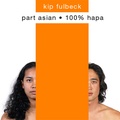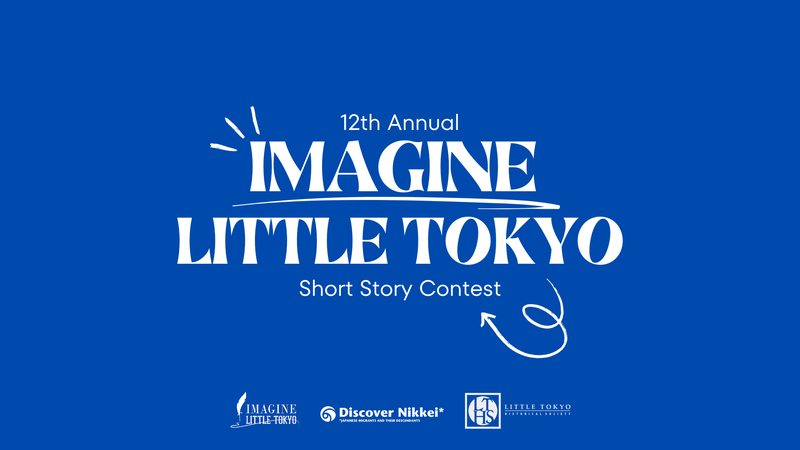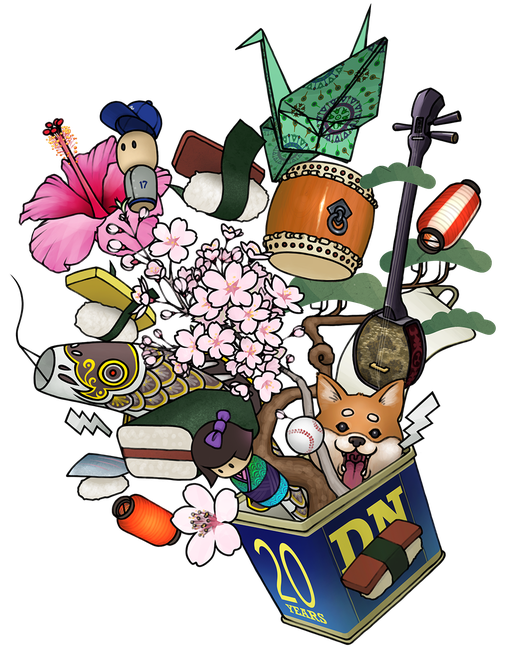What has the feedback been like?
Tremendously positive. I’ve gotten so many touching letters and emails, people telling me the book brought them to tears ... It’s really wonderful to know something I created has touched so many people. At the same time, it’s also been a bit humbling. Here I am working as an artist and filmmaker for twenty years doing autobiographical work, and within three weeks of launching thehapaproject.com, it was getting ten times the traffic of my original artist site. I tapped into something much, much larger than my own work.
Have you had any negative reactions?
No serious ones to speak of. Certainly none to my face. I’m sure there are haters out there, like there are for anything. And certainly the bigger you get in the public consciousness, the more people come after you. One result of the Internet’s growth is it has cradled a burgeoning sense of passive aggressivity to go with our culture’s already very healthy sense of self-righteousness. It’s very easy to hide behind a keyboard and flame someone. There’s really no risk. For that reason, when I took over as Department Chair at UCSB, I made a “no email” rule. If someone wanted to discuss something politically charged with me, they had to make an appointment, sit across from me, and look me in the eye. Worked like a charm.
We got a couple silly contacts out of thousands. The Japanese American National Museum received a letter saying I shouldn’t be showing there since I wasn’t J.A. Some MySpace freak went off on my assistant because I don’t participate in online forums (!). A white supremacist sent me a “scientific” paper about why miscegenation is genetically problematic. And once in awhile we’ll get something from a person claiming they own language and I can’t use this or that term. It’s just the odds, really. The bigger the audience, the more freaks.
How did the Polaroids come about?
Initially, when I was offered the show at the Japanese American National Museum, I was both honored and panicked. How could I keep audience attendance up for a 5-month run? I decided to created an interactive component where participants could take their own pic and write their own statement, then post it on a series of shelves, thinking this would get visitors more individually involved in the project and possibly create repeat visits as it changed and grew over time. To me, it didn’t matter if participants were Hapa in my view or not. Identity is, at its core, a deeply personal and individual decision, and a mandate of this project for me was to never tell anyone else what they were or could be or could not be. Identity is something for each individual to decide … which is why the project includes people who don’t always fall into the conventional definition of Hapa. The way I looked at it, if you want to be a part of this project, then you’re part of this project. Race is a social construct anyway – we’re all essentially African.
I had hoped the shelves would fill in 5 months, but they filled the first night with over 500 Polaroids. And as the show extended, they multiplied and began creeping across the adjacent walls, even into the next gallery, which wasn’t scheduled for my work … like an identity virus. I was really happy about that. I think as the show went on, visitors were more interested in the Polaroids than they were in my original work.
Have you found anyone else doing similar work?
I already knew a bunch of great Hapa artists – Greg Pak, Eric Byler, Erika Anderson, Albert Chong, Laura Kina, Erin O’Brien, Alison De La Cruz, Amy Hill, Kate Rigg, Stuart Gaffney, etc. It’s a pretty connected community. But through the project I got to meet many more artists in person (Ben Sloat, Jeff Chiba Stearns, Dorothy Imaguire) and hear about many more I hope to meet in the future.
Probably one person who I share a lot of strategic similarities with is Frank Warren who created Postsecret. We spoke together out in St. Louis recently, and realized our projects were kindred spirits in their methodology. Essentially, both of us just created safe forums for individuals to express themselves. And both of us have been touched with how confessional and honest our participants have been.
Did you make a lot of money on the book?
Originally, I wanted to make an ongoing series of books to keep the project going. But economic reality trumped that idea pretty quickly. I’ve lost track, but I’m sure this project has put me at least $10K in the hole. Part of that is the reality of publishing, globalization, and corporate marketing. But part of it was also my own conscious decision in that I chose not to make sellable prints. Sure, a couple people might buy their own or their child’s image, but I knew these prints weren’t going to make any commercial gallery solicit me to show because there was no financial incentive for them. In fact, I knew going in I would probably not even recover the initial cost of printing and hand framing the images. I also chose to give every person in the book an individual print as thanks.
It’s funny when I hear people talk about how much money I (or anyone) make off writing books. Here’s a reality check – my advance for 100% Hapa was $20,000.00. Take out agent fees and taxes and that’s somewhere around $12K, which covered some of my equipment and a couple shoots. Everything else – traveling cross country numerous times, lodging, food, printing costs … plus hiring a book designer, web designer, two digital compositors and assistants came straight out of pocket or on the backs of my generous friends, volunteers, and students.
So what it comes down to is no, I didn’t make any money on the book or project itself. But for what it did for my art career – both professionally and personally? I can’t put a price on that. It’s a project I’m immensely proud of and the feedback I’ve received has been worth more than I can say. I’ve also restructured my career as a professional artist to compete more as a speaker than as a photographer, writer, illustrator or filmmaker (though I still do all these things). On a larger scope, the project has helped push the idea of ethnic identity and the whole concept of multiraciality further into the public discourse and that’s valuable. All these intangibles feed me as an artist and as a teacher and as a person. I can’t imagine doing any other job. So when your kid tells you they want to be an artist, maybe it’s an idea worth listening to.
You know what? I had this idea a long time ago and …
This is one of my favorites. Maybe it’s because the book taps into some very personal issues with individuals, but a lot of people seem to think they have the right to tell me what I should or shouldn’t do as an artist. I’ve received lengthy emails telling me how to proceed or what to change, and stopped many a potentially lengthy conversation from (usually) well-meaning people wanting to be producer/director to my artmaking process. I’ve even had people tell me what project to do next. The implicit ownership is really astounding.
Can we have the exhibit for free? Can you speak at … edit my poetry … perform for our …?
I think this ties into the way our culture really doesn’t value or respect art and teaching. Any reality show cast-off gets more press and crowds than a writer or teacher, be they critically acclaimed or not. We watch Sotheby’s sell a Picasso or a Star Trek model for an astronomical sum and say “Wow,” but we steal independent work without a second thought, be that images, music, writing, poetry, even jokes. It’s the prevailing attitude contained in the request to speak for free, to use one’s images for free, to reproduce one’s writing for free, to ask for time. I guess the basic tenet is this: making art is not a hobby or a pastime. If it were, the people doing it for a living wouldn’t be doing it for a living. Teaching is the same way. We pay our teachers nothing and hope they change the world, but we’d never ask a plumber to fix a sink for free.
I insist my students take their work seriously and show it proper respect, because if they don’t do it, no one else will. I’ve helped train a dozen teachers and I hope to train dozen more.
How did you come to show at the Japanese American National Museum when you’re not J.A.?
I like this question, because in many ways I feel such a kindred spirit with J.A. communities. For whatever reason, I’ve been involved either directly or peripherally with a lot of Japanese and J.A. cultures … I studied the language in college, lived there several times, earned my shodan in shotokan. I wanted a place to launch the show and the book, and the Japanese American National Museum was my first choice. Certainly the J.A. community is very Hapa aware, but if you think about it, it took tremendous guts and a keen sense of the future to schedule this type of show – the first of its kind – at a major museum. My hats are off to Karen Higa for seeing the potential and taking that risk.
I really appreciate them taking a chance on me (being a non-J.A.) and hosting the show. Lisa Sasaki, Clement Hanami, and the rest of the staff were great. And Mariko Gordon is my hero!
What are you doing next?
My next book is really a sequel to 100% Hapa. It’s titled Permanence: Tattoo Portraits by Kip Fulbeck and it’s being released Spring 08 by Chronicle Books. Just as 100% Hapa isn’t really about race – it’s about identity using race as a starting point – Permanence isn’t really about tattoos. It’s also about identity. 100% Hapa looks at identity from the inside out. Permanence looks at identity from the outside in.
We’ll be launching the book and exhibit at Ghettogloss Gallery in Silverlake March 20th, then in San Jose at State of Grace Tattoo March 22nd. I’ll promote the book for several months, and then it’s back to the drawing board for the next project. All I can tell you is it will be based on something I’m part of, something that’s core to me. I would question a Hapa book made by a non-Hapa, just as I question tattoo work done by people without tattoos. I’m very conscious of not wanting to be a photographer that comes in and shoots others. I want to be part of the communities I explore.
*kip fulbeck: part asian, 100% hapa is an exhibition of portraits by artist and filmmaker Kip Fulbeck. The exhibition is showing at the 7th Floor Gallery at A/P/A Institute in New York City through May 30, 2008. For more information visit the exhibition Web site.
**Discover Nikkei asked Kip to share his views on the exhibition and its impact, and he responded with a list of frequently asked questions along with his answers. -.ed
© 2008 Kip Fulbeck








